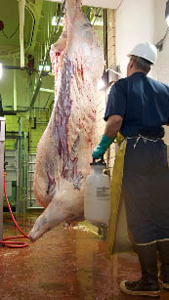
|
| Photo courtesy of Christopher Raines |
boot- scrubbing system, put on personal protective equipment (PPE) such as gloves, masks and goggles, and their movement is restricted to prevent any contamination.
Certainly, meat and poultry processors have made tremendous improvements to their sanitary standard operating procedures (SSOPs) in the past 10 years, and continue to develop new methods to control foodborne illnesses through sanitary plant design.
“Plant designs have become much better in regard to the cleanability of the entire envelope instead of just the functionality of the building and equipment,” says John E. Johnson, general manager for a JBS-Swift case-ready facility, Greeley, Colo.
These changes are largely due to the 2003 U.S. Department of Agriculture’s Food Safety and Inspection Service’s (FSIS) interim final rule requiring federal establishments producing certain ready-to-eat (RTE) meat and poultry products to take steps to reduce the incidence of Listeria monocytogenes contamination, and document (and verify) their control measures.
“The extra emphasis and regulatory concern from the government and increased public awareness pushed the meat industry to improve its equipment and facility design,” says Lee Johnson, Ph.D., vice president of technical services, West Liberty Foods, based in West Liberty, Iowa.
As a result, the design of equipment and facilities has improved so that equipment is now easily accessible and cleanable to a microbiological level, which is further documented with SSOPs that regulate dry cleaning, pre-rinsing, foaming, scrubbing, rinsing and visual inspection. In addition, the post-processing environment undergoes the same scrutiny.
Sealing off contaminants
“Regarding improvements in facility construction, we [also] know so much more now about the need to separate raw from RTE and air controls to reduce condensation — and even building materials have improved to increase life expectancy and therefore require less maintenance,” says Joe Stout, former global director of product protection and hygienic design for Kraft Foods Inc. and current president of Commercial Food Sanitation, LLC, based in Chicago.
Today, West Liberty Foods’ team, for one, is focusing on how to design its building layout to prevent cross-
contamination and control forklift traffic, says Johnson.
“We’ve redesigned our plant traffic flow to better cater to our RTE products, with one side of our plant devoted to RTE slicing and packaging lines, which have their own individual slicing ‘cells,’” says Johnson.
The West Liberty Foods’ “cells” are well-known for their complete isolation from the surrounding environment to prevent cross-contamination. Employees enter wearing clean, full-body suits. Product casings are first treated with food-grade antimicrobials before entering the cell. And each cell has its own drain (to dispose of copious amounts of floor sanitizer) and air-handling system (to filter out airborne Listeria and ambient air).
Retrofitting older plants
According to John Johnson, probably the biggest challenge for plant designers is retrofitting older plants to meet today’s more rigorous standards, with more work still needing to be done in this area.
“It is easy to build green-field plants and is oftentimes cheaper than trying to retrofit an older plant with new designs. Constraints on floor space, non-compatible materials, older infrastructures — for example, plumbing, pneumatics, etc. — are a high hurdle,” he says.
Today’s more modern plants are designed to adapt to new equipment, notes Christopher Raines, Ph.D., assistant professor of meat science, department of dairy and animal science, The Pennsylvania State University, based in University Park, Pa., and their designers also factor in Listeria’s well-documented obstinacy.
“The challenges for RTE meat products in older establishments will probably get more difficult,” he says, with very small plants facing the largest obstacles. “Often, they are able to obtain a grant of inspection for fresh product but not RTE product.”
The recent Food Safety Modernization Act may also put more pressure on smaller plants in particular as it requires more documentation and records of sanitary handling of food, says Stout.
In addition, all plants managers need to be aware of “sandwiches” — an area where two pieces of equipment material meet, are not hermetically sealed and cannot be dissembled for cleaning, notes Stout.
“A good example seen too frequently is conveyor rails — either side or bottom support or guide rails — that are made of slotted UHM and pressed into a stainless-steel channel,” he says. “These create perfect ‘sandwiches,’ as they are an area where moisture can harbor without being reached with detergents, mechanical action or sanitizers.”
Freezers also pose cleaning challenges, although they have come a long way in recent years and can be purchased with clean-in-place (CIP) capability and fully welded panels.
“However, there is still too much moisture which collects at the in-feed and exit points, which has the potential to form condensation,” says Stout. “There are formulas that can be used to figure out the dew points that would minimize this. It may mean an extension on a freezer to gradually allow temperatures to calibrate, other dehumidification techniques that could be employed or both to get this under control.”
Automating cleaning systems
Lee Johnson says that processors will only continue to improve sanitary equipment design and automation in cleaning and processing practices.
“I see meat plants becoming more like aseptic filling and canning operations where processes are less reliant on manual activities and more and more CIP systems and automated cleaning equipment are built into the design of the facilities,” he says.
Automated cleaning systems eliminate the human variability factor associated with manual cleaning practices, such as the traditional foam and mechanical actions used to remove soil, and training challenges on proper cleaning procedures, says Stout.
Raines says that CIP processing equipment will become even more streamlined.
“Advancements are being made with antimicrobial packaging systems — which is antimicrobial activity beyond an ingredient — such as bioactive packaging films,” he says. “More antimicrobial processes such as HHP [high hydrostatic pressure treatment] and ingredients, especially ‘natural’ ones, will be explored.”
Plant designs will only become more flexible with their utilization of materials and the functionality of the design, notes John Johnson.
“The envelope in which equipment is used will be more dynamic and not rigid to only accommodate one type of processing,” he says.
| By the Book |
|
Since 2003, the Washington, D.C.-based American Meat Institute’s (AMI) 11 Sanitary Design Principles for Facilities has been a handy reference for meat processors looking to upgrade their facilities and avoid food recalls. Here is another look at the trusty guidelines:
|





Report Abusive Comment